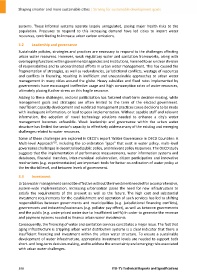Page 518 - Shaping smarter and more sustainable cities - Striving for sustainable development goals
P. 518
systems. These informal systems operate largely unregulated, posing major health risks to the
population. Pressures to respond to this increasing demand have led cities to import water
resources, contributing to increase urban carbon emissions.
3.2 Leadership and governance
Sustainable policies, strategies and practices are necessary to respond to the challenges affecting
urban water resources. However, weak regulatory water and sanitation frameworks, along with
overlapping functions within governmental agencies and institutions, have led to an unclear division
of responsibilities and to uncoordinated efforts in urban water management. This has caused the
fragmentation of strategies, as well as redundancies, jurisdictional conflicts, wastage of resources
and conflicts in financing, resulting in inefficient and unsustainable approaches to urban water
management in many cities around the globe. Heavy subsidies and fixed rates implemented by
governments have encouraged ineffective usage and high consumption rates of water resources,
ultimately placing further stress on this fragile resource.
Adding to these challenges, sectoral politicization has fostered short‐term decision‐making, while
management goals and strategies are often limited to the term of the elected government.
Insufficient capacity development and outdated management practices cause decisions to be made
with inadequate information, or lead to poor implementation. Without capable staff and relevant
information, the adoption of novel technology solutions needed to enhance a city's water
management becomes unfeasible. Weak leadership and governance within the urban water
structure has limited the sector's capacity to effectively address many of the existing and emerging
challenges related to water resources.
Some of these challenges are explored in OECD's report 'Water Governance in OECD Countries: A
10
Multi‐level Approach' , including the co‐ordination "gaps" that exist in water policy, multi‐level
governance challenges in decentralized public policy, and relevant policy responses. The OECD study
suggests that the implementation of performance measurements, water information systems and
databases, financial transfers, inter‐municipal collaboration, citizen participation and innovative
mechanisms (e.g. experimentation) are important tools for better co‐ordination of water policy at
the territorial level, and between levels of government.
3.3 Investment
Urban water management cannot be effective without the investment needed for a comprehensive,
system‐wide implementation. Increasing urbanization poses the need for new infrastructure to
satisfy the requirements of the present as well as the future. The high cost and substantial
investment requirements for the establishment and operation of such services has led to shifting
responsibilities between governments and municipalities (e.g. jurisdictional financing conflicts),
governments and industries/businesses (e.g. polluter pay effect), as well as between governments
and the public (e.g. underpriced water due to insufficient tariffs) in order to generate the revenue
and payment systems needed to finance urban water investments.
Consequently, the financing of water and sanitation services constitutes a major issue. The fact that
aging infrastructure is crippling urban water distribution systems is a clear indicator that there is
insufficient financing and investment within the urban water structure. To ensure a sustainable
development of water infrastructure, appropriate investment levels are needed to support both
short‐ and long‐term decision‐making, and to address the uncertainty and emerging risks associated
with urban water challenges.
508 ITU‐T's Technical Reports and Specifications

